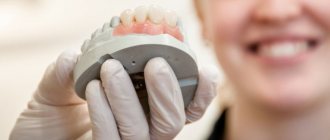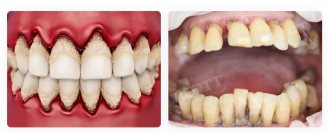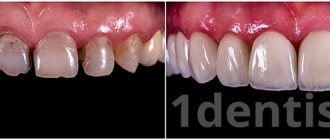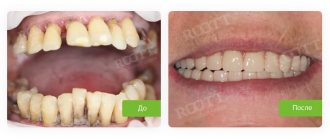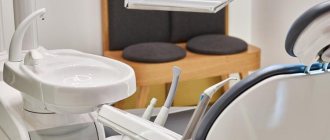Hard tissue preparation, also called grinding, is used to prepare for the installation of artificial crowns and dental bridges in the jaw. This procedure has its disadvantages, so many patients seek to avoid it. Modern orthopedic dentistry offers alternative methods of prosthetics, the use of which does not require injuring the supporting teeth and compromising their integrity.
Structures with interlocking connections
For prosthetics of one or two teeth without turning adjacent units, the CBW prosthetic system can be used. Its features:
- Small canals with a diameter of about 1 mm and a length of 1.5-2 mm are formed on the lateral parts of the supporting teeth.
- Locks made of titanium or zirconium are inserted into these microcavities and secured with glue.
- The intermediate part of the prosthesis is fixed with installed locks.
This method makes it possible to save adjacent teeth, but it is more often used as a temporary option, since CBW systems cannot be called durable.
Micro locks (CBW system)
To install the structure, several types of locks are used. Based on the material used, there are two types:
- Zirconium. They have high aesthetic properties and are installed only on thin ceramic crowns.
- Metal. They are the most popular and are designed for installation on standard crown widths. Can be combined with bridges made of synthetics, metal or acrylic.
Clasp for 2 teeth
Regardless of what material micro-locks are made of, they are divided into three types.
- The first type includes locks for the chewing area, which are the largest of all three types. The design is made only of metal and has an oval platform with a small rotation pad. The fastening element is made in the shape of a rectangle with curved edges.
- Universal locks are made of metal or ceramic with a rectangular platform. The fixing part has the shape of a trapezoid and completely follows the transverse shape of the teeth. The base of the product is supplemented with a wide rotational pad, which increases the service life of the structure.
- Microlocks for the frontal area are very miniature and differ from other designs in the absence of a rotation pad.
There are two types of fastening method:
- Hard. The two parts of the clasps are connected to each other using cement in such a way that a fixed structure is obtained for installation in the front part of the jaw. Rigid fastening has a small price, but there are risks of product breakage.
- Labile. Connects the tooth to the bridge, the lock is equipped with a special sleeve that ensures sliding like a real tooth.
The main advantage of prosthetics with micro-locks is the quick installation of products and the absence of pulp removal. The disadvantages include the fragility of the design.
Adhesive prostheses
This is a relatively new technique for restoring the integrity of the dentition with minimal preparation of supporting units. At the same time, the latter are not depulped, that is, they remain “alive”. And they are not covered with artificial crowns. To install an adhesive prosthesis:
- Shallow grooves are sawed on the teeth adjacent to the defect;
- a prosthesis on a beam is installed in the prepared “niches”;
- From above, the fixation site is covered with composite materials.
Adhesive prosthetics is a progressive and affordable alternative to the installation of metal-ceramic bridge structures. One of its advantages is the ease of replacing such a system if the patient desires to choose a different method of dentition restoration.
Prosthetics with flexible nylon prostheses
If in the two previous methods it was possible to restore only one tooth, then the use of nylon dentures allows you to recreate several consecutive teeth, and in some cases, the entire dentition of the upper or lower jaws. This manufacturing option is comparable to conditionally removable or even complete removable prosthetics.
Nylon is light, thin and extremely flexible. It is used in construction as a frame (base) on which one or more artificial teeth are attached. It is due to the special properties of nylon that the prosthesis tightly grips the gums and supporting teeth, while at the same time very softly adhering to one of the palates.
Manufacturing:
- As usual, silicone impressions are first made of the problem area of the oral cavity and the surrounding mucous membrane.
- Then, using a special apparatus, the frame of the future prosthesis is cast over them under very high pressure.
- The required number of dental crowns are attached to the resulting base.
Advantages of the method:
- Allows you not to feel the prosthesis in your mouth. The old type of removable dentures put pressure on the gums, so most patients treated them very poorly. But nylon structures are not felt in the mouth after about a week of using them.
- An allergic reaction is excluded, because the prosthesis does not contain any metal ions, but monomers.
- The structure is securely and firmly attached. If it is a complete removable denture, then it is attached without the use of additional adhesive materials; if it is partially removable, then nylon clasps are used for fixation, which are secured to the supporting teeth.
- Nylon does not absorb other substances, including dyes, and remains translucent throughout its service life.
- Dentures do not require special care.
Disadvantages of the method:
- The pattern of the mucous membrane of a person’s mouth changes over time, and the prosthesis in areas of contact with it will begin to rub the tissue of the mucous membrane. In this case, adjustments to the entire structure are required.
- They wear out quite quickly. Their service life is two to three years.
- High price. The price of such a prosthesis is approximately twice as high as the cost of a rigid plate prosthesis made of acrylic.
Implantation
In terms of efficiency, aesthetics and functionality, no method of treating partial edentia can be compared with implantation. When using this method of prosthetics without turning, not only the visible part of the tooth is restored, but also the root is modeled. Its function is performed by a titanium implant implanted into the jaw. A crown is installed on top of it in a special way.
Advantages of implantation over other methods of prosthetics without turning:
- Safety. Healthy teeth are not affected at all.
- High functionality. The created system imitates a natural tooth, that is, it also loads the jaw and prevents its resorption (resorption).
- Impeccable aesthetics. Crowns on implants look attractive and are difficult to distinguish from natural teeth.
- Durability. Such structures can last 10-15 years or more.
Free consultation
30-40 minutes
inspection and diagnostics
treatment plan and cost
Make an appointment
Prosthetics using inlays
When a tooth is very badly damaged and it is impossible to create a filling that would exactly replicate its previous shape, they resort to prosthetics using the inlay method. Previously, such a tooth inevitably had to be ground down in order to cover it with a crown, but now, thanks to inlays, the destroyed fragment of the tooth is completed without destroying it even more.
An impression is taken of the damaged tooth and its adjacent supporting teeth, from which an inlay of the desired shape will be created in the laboratory. It is created from a composite material or ceramic and will be shaped like a regular filling. Then such an inlay is cemented.
How to choose a method of prosthetics without turning?
Each of the methods discussed above has its pros, cons, indications and contraindications. Therefore, when choosing, you should rely not only on your own preferences and wishes, but also on the recommendations of an experienced dentist.
During the consultation, the doctor will determine possible prosthetic options in your case. He will make recommendations based on the clinical situation and give you the opportunity to make a decision. Together with a specialist, you will choose the best way to restore the beauty of your smile and normal chewing function.
Prosthetics of teeth without turning adjacent teeth - advantages and disadvantages
Today, prosthetics without grinding teeth attracts many people. Using this method, various dentures are installed without grinding adjacent teeth.
Advantages of the technology under consideration:
- Nerves are not removed and blood vessels are not harmed;
- the manipulations are not accompanied by severe pain;
- short duration of the operation;
- the integrity and nutrition of neighboring teeth are preserved;
- the design is aesthetically perfect;
- low cost;
- no surgical intervention required;
- the denture can be easily replaced with another type of product;
- care that does not require special skills and is not difficult;
- getting used to changes happens quickly.
The procedure involves making a depression into which a micro-lock is later attached using dental cement. Next, a customized denture is made for the patient and installed.
There were some shortcomings. This type of dental prosthetics also has disadvantages:
- Strength is low. The installed support is not intended for external pressure. Consequently, the devices are not durable;
- A small list of indications. The type of correction under consideration is used in specific situations;
- Poor choice between materials. For example, fixed substances that deteriorate within a short period of time are often used.
Indications and contraindications for use
The method can be used in the following cases:
- the presence of weak, brittle enamel;
- missing several teeth;
- looseness of dental units that play the role of support in other types of prosthetics;
- diseases associated with the surface of the teeth, prohibiting grinding and turning;
- the presence of large interdental distances;
- minor to significant damage to the crown.
There are contraindications:
- nerve problems;
- the person has recently had radiotherapy;
- dental, inflammatory diseases;
- body rejection of anesthesia;
- a strong gag reflex;
- poor oral hygiene;
- diseases of the bone tissue of the jaws;
- addictions (drugs and alcohol).
You can begin treatment after eliminating the difficulties associated with the contraindication.
Prosthetics with CBW
a method of prosthetics without grinding adjacent teeth Crownless Bridgework
CBW – Crownless Bridgework. This system is installed when the neighboring teeth are healthy and act as supports for the structure. The device is a durable bridge-like prosthesis, attached with the help of locks to the holes made in the dental units located in the vicinity.
The method allows you to avoid excessive load on individual points (it is distributed evenly), and prevent damage to the gums due to pressure. The procedure goes quite quickly. The product type can be changed at any time. In this case, the holes in the locks are sealed.
It should be noted that the design is short-lived.
Adhesive bridges
Adhesive bridge
The technology is similar to the previous one, since its implementation requires healthy incisors on the sides. The technique consists of making grooves on the supports for a dental frame made of glass fiber. The method is gaining popularity due to many advantages:
- eliminating the possibility of allergies to materials,
- maintaining the integrity of supporting teeth,
- durability,
- possibility of replacement without harm.
The aesthetics of an adhesive bridge, unable to withstand high pressure, is at a low level.
Microprosthetics
This is what ceramic veneers look like
. Veneers are one of the types of microprostheses. They are plates placed on the front side of the tooth. Used for various external damages (irregularities, discoloration due to smoking, chips, cracks, abrasion). There are porcelain and ceramic. Onlays can make a smile beautiful by hiding problem areas and, to some extent, closing large interdental spaces. Lumineers have the same operating principle as veneers, but are thinner.
Thin, white inserts are fixed on the front surface of the teeth and perfectly hide all visible defects in the dentition. They can replace the destroyed coronal part. There are metal and ceramic. They differ from fillings in their more precise production and longer wearing period. Made individually to the shape of the recesses.
Dante's method
The method was developed by dentist Alexander Dante. A laser is used to create tubules in the supporting dental units for the installation of a carbon structure. It is then processed using special geopolymers. The prosthesis is characterized by high strength, correct load distribution, and the absence of the likelihood of an allergy to a foreign body.
Implantation
sinus lifting and implant installation
This prosthetics is the most common, reliable, and effective compared to others. The procedure does not require supporting, adjacent teeth. The essence of the implantation technique is to completely replace a destroyed dental unit (there may be a group of them) with a new one.
First, the bone is prepared and, if necessary, bone tissue is built up. Next, a special pin is inserted, which is the basis, the support. A crown is attached to it. It can be temporary or permanent. There are options in which a pin is inserted immediately after creating the recess. The implant is permanently attached, it is implanted into the bone.
Implantation has many advantages:
- no need to use other teeth;
- durability;
- atrophy of soft tissues is excluded.
The main disadvantage is the long healing period.
Cable prosthetics
A special prosthesis is installed using a strong aramid thread attached to the channels made on the supporting incisors. The holes are fixed with dental cement.
The method under consideration is suitable for people with periodontal inflammation. The device does not come into contact with the gum. Rarely causes allergic reactions in patients due to hypoallergenic materials. The product is inexpensive and accessible to most patients. The main advantage is that the teeth remain mobile. The disadvantages include low aesthetic parameters, since the thread used is visible through the filling substance. The doctor uses the method for minor injuries.
Nylon dentures
nylon denture
Such dentures allow you to restore a whole range of dental elements. The design is considered removable and is made of silicone to eliminate the possibility of damage to soft tissues and is hypoallergenic. It follows the shape of the gums and palate and fits tightly to them during use. It has clasps that fit over teeth that do not need grinding. Thanks to the manufacturing material, quick adaptation occurs. Despite its flexibility, the device is resistant to various types of influences. The wearing period is short, approximately 3 years. To carry out manipulations, there is no need to surgically damage soft or bone tissue. You can change your prosthesis at any time. It does not require fancy care. The disadvantages are the high cost (of high-quality models), the likelihood of chafing.
Butterfly
Butterfly denture
Used for one missing tooth. It is considered the simplest prosthesis to use and manufacture. It is a crown that is installed using fasteners (clasps) on adjacent teeth. Fastening elements can be plastic, metal, silicone. If they are made of metal, they will be very noticeable. Those made of plastic can be red (the color of the gums) and thus are invisible. When actively wearing the prosthesis, there is no discomfort.
It is considered temporary, although many people wear it for a long time. It is contraindicated for patients with highly mobile elements of the rows. The disadvantages include poor fastening of the crown in the mouth, which leads to frequent visits to the treating dentist.
Which technique should you choose?
The selection of a prosthetic method without turning is carried out by a doctor based on the condition of the mucous membrane, soft tissues, and teeth in the oral cavity. The doctor takes into account the degree of damage, the patient’s financial capabilities, and his preferences.
In case of significant damage to the bone tissue of the teeth or periodontal inflammation, reliable implantation is suitable, which is used in most cases. If damage to the incisors located in the lower row is observed, it is recommended to use the Crownless Bridgework system. For damaged upper incisors, an adhesive bridge should be used due to its effectiveness or CBW. If a person’s financial situation is poor or a group of teeth is missing, one should resort to nylon dentures.
When a patient needs to restore the aesthetics of his front teeth, microprosthetics (veneers, lumineers, inlays, etc.) are used, quickly tidying up the meager appearance of a smile. If contraindications are identified, diseases that interfere with prosthetics are first treated. Doctors from different fields of medicine may be involved in treatment.
Patient reviews
Hello. I had nylon dentures done, although they say that the service life of such dentures is a maximum of 3 years, I have been wearing them for 5 years already. The product really fits perfectly; over the years I have never seen any flaws.
Marina, Nizhny Novgorod
I had implantation done, it was very painful, and my recovery period was six months.
Dmitry, Ivanovo.
Hello.
Three years ago I had an inlay made; it fell off within a year. A waste of time and money. Having contacted the dentist, we came to the conclusion that we would remove the tooth and do adhesive prosthetics. Svetlana. Novokuznetsk.
Preparation
Before clasp prosthetics, the dentist must carefully examine the condition of all units in the dentition and carry out treatment of the oral cavity. Remove carious lesions and tartar, eliminate inflammatory processes. Before prosthetics, teeth in poor condition must be removed. They cannot be left in the dentition, since the clasp denture will be made taking into account problem teeth. If they fall out on their own or need to be removed after prosthetics, the entire clasp structure will have to be redone.
After treatment, the orthopedic dentist examines the condition of the supporting teeth and determines the type of clasp denture. Next, the supporting teeth are ground to the required size and a cast of the entire jaw is made. It will be used to make a clasp prosthesis and crowns for ground teeth. Their production will take up to several weeks. While the crowns and the partial denture itself are being made, the ground teeth are protected with a temporary plastic crown. Subsequently, permanent metal-ceramic analogs with fastening elements of the clasp structure will be installed in their place.
The prosthetics itself does not take much time. The dentist tries on the prosthesis and secures it. If necessary, it is sent to a dental laboratory for revision. After prosthetics, the patient is taught how to remove and put on a clasp prosthesis correctly, and is also given recommendations on how to care for it.
Caring for a clasp denture
The prosthesis will last you up to 5 years, provided that you take care of it. Here are some recommendations for caring for it:
- Remove the clasp denture regularly. It needs to be removed and cleaned every day. Once every few days, dentists recommend immersing it in an antibacterial solution for 10 minutes to disinfect.
- Do not use abrasive pastes or hard brushes. They help to erase the acrylic elements of the clasp structure.
- Do not keep the prosthesis in water. If you remove such a structure, you need to wash it, dry it and put it in a case; keeping it in a glass of water is not recommended.
- Do not overload the prosthesis. Avoid large pieces of hard food that are difficult to chew. Sticky and viscous food is also dangerous; it can lead to breakage of the entire clasp structure.
- Visit your dentist once every six months. He will inspect the condition of the clasp structure and make the necessary adjustments.
Procedure
Any methods of dental prosthetics without grinding must be performed by a highly qualified specialist. The product installation procedure itself is carried out in several stages:
- Examination. The oral cavity is examined and the doctor prescribes x-rays to assess the condition of the dental tissue and pulp cavity.
- Preparatory stage. Having carried out a complete sanitation, the dentist begins prosthetics. Using alginate mass, the doctor makes impressions and selects a shade for the crown. Then he selects the type of locks.
- Crown alignment.
- Positioning. On the aligned parts, stepping back 1 mm from the gingival papilla and from the middle, as close as possible to the lingual surface, determines where the lock will be located. The location is marked with a marker.
- Preparing the hole. After preparation, the canal is deepened at the marked point using a dental bur. The finished well is then cleaned with a brush, rinsed with water and etched with phosphoric acid for 30 seconds.
- Installation of a micro-lock. Having disinfected the products with an antiseptic and introduced cement into the canal, install locks and press them a little into the canal for better strengthening.
- Manufacturing and installation of a prosthesis.
When the prosthesis is installed, the specialist carries out polymerization and removes excess adhesive solution. After which the surface is polished.




